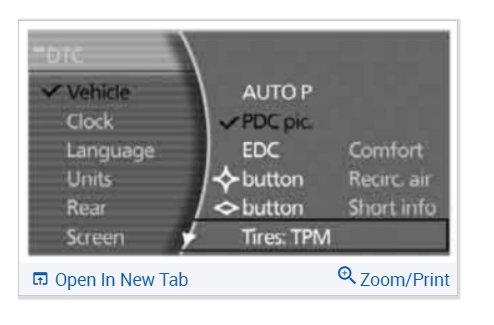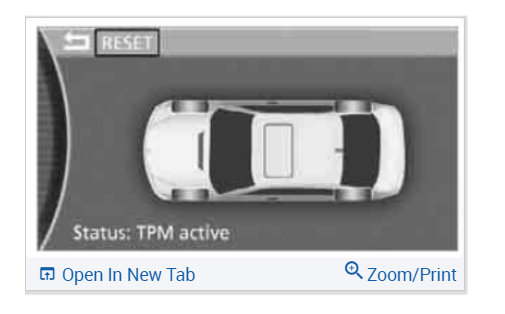Hi Sam,
Have you installed new tires on the car recently? If so, what happens is one of the sensors gets damaged, we will need to scan the car to see which one is not working or you may be able to navigate through the prompts on the car to see which tire is not registering. This guide and video will show you what to do if you are unsuccessful with the internal diagnostics:
https://www.2carpros.com/articles/can-scan-controller-area-network-easy
Let us know what happens and please upload pictures or videos of the problem. I found this info on the system which can help as well, check the diagrams as well at the bottom.
Tire Pressure Monitor TPM
The Concept
TPM checks the inflation pressures of the four mounted tires. The system notifies if there is a significant loss of pressure in one or more tires.
Functional Requirement
In order to assure the reliable reporting of a flat tire, the system must be reset while all tire inflation pressures are correct. Always use wheels with TPM electronics. Otherwise, the system may malfunction.
Note: Each time a tire inflation pressure has been corrected or a wheel or tire has been changed, reset the system.
System Limitations
Caution: TPM cannot warn you in advance of sudden severe tire damage caused by outside influences.
The system does not work correctly if it has not been reset, for example, a flat tire may be indicated even though the tire inflation pressures are correct.
The system is inactive and cannot indicate a flat tire if a wheel without TPM electronics, such as a compact spare wheel, has been mounted, or if TPM is temporarily malfunctioning due to other systems or devices using the same radio frequency.
Status Indicator on the Control Display
The color of the tires represents the status of the tires and the system.
TPM takes into account that tire pressures change while the vehicle is being driven. The tire pressures do not need to be corrected unless the TPM instructs you to do so by means of color indicators.
"Green"
The tire inflation pressure corresponds to the established target value.
"TPM active" appears on the Control Display.
"One Wheel Yellow"
There is a flat tire or substantial loss of tire pressure in the indicated tire. A message appears on the Control Display.
"All Wheels Yellow"
There is a flat tire or substantial loss of tire pressure in several tires. A message appears on the Control Display.
"Gray"
The system cannot detect a puncture.
Possible reasons for this:
TPM is being reset
Temporary malfunction caused by systems or devices using the same radio frequency.
Malfunction
Resetting the System
NOTE: Reset the system again after each correction of the tire inflation pressure and after every tire or wheel change.
Resetting finishes during driving, which can be interrupted at any time. When driving resumes, resetting is continued automatically. Do not reset the system when driving with a compact wheel.
1. Press the MENU button to open the start menu.
2. Move the controller toward "Settings".
3. Select "Vehicle" and press the controller.
4. Select "Tires: TPM" and press the controller
5. Start the engine, but do not begin to drive.
6. Select "RESET" and press the controller.
7. Select "YES" and press the controller.
8. Start to drive.
The tires are shown in gray and "Status:
Resetting TPM..." is displayed.
After a few minutes of driving, the newly corrected inflation pressures in the tires are adopted as the set-point values to be monitored. The resetting process is completed during driving. The tires are displayed in green on the Control Display.
If a flat tire is detected during the resetting and adoption of the tire inflation pressures, all tires are shown in yellow on the Control Display. The message "Status: Tire low!" is displayed.
Low tire pressure message
The warning lamp lights up yellow. A message appears on the Control Display. In addition, a signal sounds. A flat tire or a major air loss has occurred.
1. Reduce speed and stop the vehicle carefully. Avoid sudden braking and steering maneuvers.
2. Check whether your vehicle is equipped with standard tires or run-flat tires. You will recognize run-flat tires by a circular symbol containing the letters RSC on the side of the tire.
Malfunction
The yellow warning light flashes and then lights up continuously. The tires are shown in gray on the Control Display and a message is displayed. No flat tire can be detected. Have system checked. A message like this is displayed in the following situations:
- When a malfunction is occurring. Have the system checked.
- When a wheel without TPM electronics is mounted.
- When TPM is experiencing temporary interference from other systems or devices that use the same radio frequency.
Declaration according to NHTSA/ FMVSS 138 Tire Pressure Monitoring Systems
Each tire, including the spare, should be checked monthly when cold and inflated to the inflation pressure recommended by the vehicle manufacturer on the vehicle placard or tire inflation pressure label. If your vehicle has tires of a different size than the size indicated on the vehicle placard or tire inflation pressure label, you should determine the proper tire inflation pressure for those tires. As an added safety feature, your vehicle has been equipped with a tire pressure monitoring system, TPMS, that illuminates a low tire pressure telltale when one or more of your tires are significantly underinflated. Accordingly, when the low tire pressure telltale illuminates, you should stop and check your tires as soon as possible, and inflate them to the proper pressure. Driving on a significantly underinflated tire causes the tire to overheat and can lead to tire failure. Underinflation also reduces fuel efficiency and tire tread life, and may affect the vehicle's handling and stopping ability. Please note that the TPMS is not a substitute for proper tire maintenance, and it is the driver's responsibility to maintain correct tire pressure, even if underinflation has not reached the level to trigger illumination of the TPMS low tire pressure telltale.
The TPMS malfunction indicator is combined with the low tire pressure telltale. When the system detects a malfunction, the telltale will flash
for approximately one minute and then remain continuously illuminated. This sequence will continue upon subsequent vehicle startups as
long as the malfunction exists. When the malfunction indicator lights up, the system may not be able to detect or signal low tire pressure as intended. TPMS malfunctions may occur for a variety of reasons, including the installation of replacement or alternate tires or wheels on the vehicle that prevent the TPMS from functioning properly. Always check the TPMS malfunction telltale after replacing one or more tires or wheels on your vehicle to ensure that the replacement or alternate tires and wheels allow the TPMS to continue to function properly.
Images (Click to make bigger)
Thursday, April 14th, 2022 AT 11:55 AM

